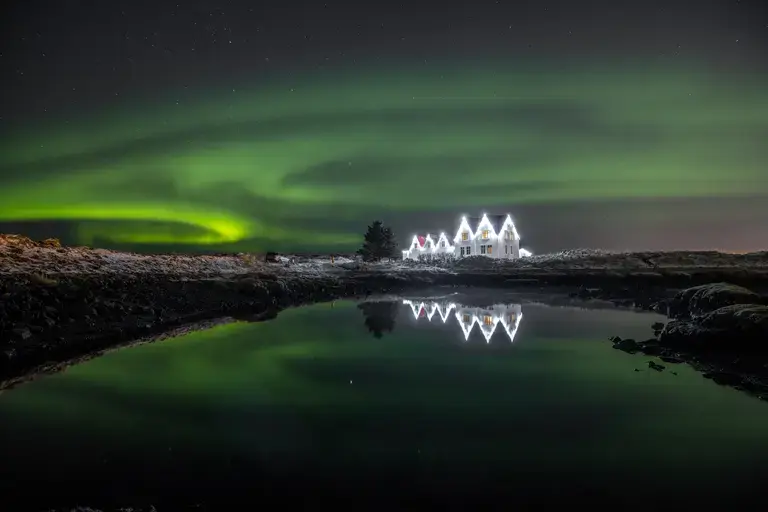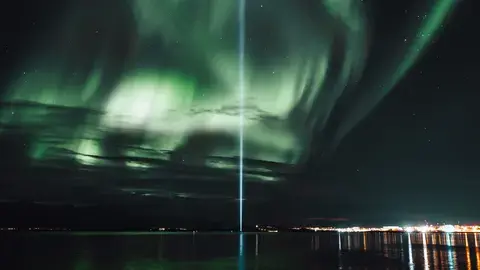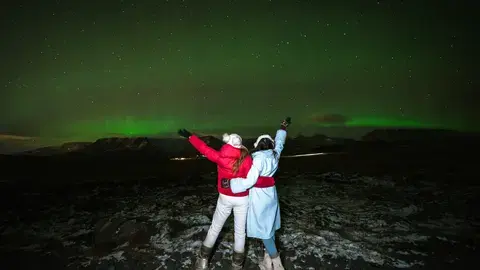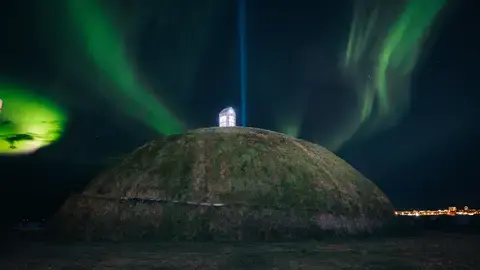
See, enjoy and photograph the Northern Lights
Iceland, with its beautiful landscapes and ethereal auroras, beckons you to delve into the mesmerizing world of the Northern Lights. As the Aurora season unfolds from late August to mid-April, enthusiasts and adventurers alike eagerly await the opportunity to behold the celestial spectacle.
How to see the Northern Lights
In your quest to witness the Northern Lights, Reykjavík presents several options to enhance your experience, with optimal viewing times during the equinoxes in September/October and March/April:
Hunting the Lights in Reykjavík: Immerse yourself in the vibrant energy of Iceland's capital city while keeping an eye out for the elusive auroras dancing above the urban skyline.
Joining a Guided Tour: Opt for a guided tour led by experienced aurora hunters who possess invaluable knowledge of prime viewing spots and optimal conditions for witnessing the Northern Lights.
Taking a Northern Lights Evening Cruise: Delight in a unique vantage point aboard a Northern Lights evening cruise, where you can marvel at the celestial display from the tranquil waters surrounding Iceland.

Chasing the Northern Lights in Reykjavík
Witnessing the mesmerizing dance of the Northern Lights is a dream for many travellers, but capturing this natural phenomenon requires patience and favourable weather conditions. If the skies are cloudy or the aurora forecast isn’t promising, Reykjavík still offers incredible opportunities to learn about and experience the Northern Lights through interactive and immersive exhibitions.
At Perlan, visitors can explore the science and beauty of the aurora through interactive displays and breathtaking photography. The highlight is the 360° planetarium show, where you can experience a dazzling recreation of the Northern Lights under a simulated night sky.
Aurora Reykjavík, the Northern Lights Center, provides an intimate and immersive experience with informative displays, stunning timelapse videos, and the cozy "Aurora Room," where you can enjoy a panoramic simulation of the aurora.
Whether you're waiting for the skies to clear or simply want to enrich your understanding of the aurora, these exhibitions offer unforgettable experiences that complement the thrill of seeing the Northern Lights in person.

Capturing the Northern Lights: Photography Tips
Photographing the Northern Lights can be as enchanting as witnessing them firsthand. Here are some tips to help you capture this celestial wonder:
Use a tripod: Stability is key for long exposure shots. A tripod will keep your camera steady and avoid blurring.
Manual settings: Set your camera to manual mode. Adjust the ISO between 800 and 1600 to capture enough light without overexposing the image. Use a wide aperture (f/2.8-f/4) to allow more light in, and set your shutter speed between 5-20 seconds, depending on the intensity of the lights.
Focus on infinity: Aurora photography requires a sharp focus on distant objects. Manually focus your lens on infinity or a distant object to achieve this.
Choose the right lens: A wide-angle lens (14mm to 24mm) will help capture the vastness of the sky and the full extent of the auroras.
Adjust your white balance: Set the white balance to daylight or around 3500K to bring out the true colors of the Northern Lights.
Scout your location: Find a spot away from city lights, or join a tour to more remote locations for the best view. If in Reykjavík, places like Grótta or Öskjuhlíð offer darker skies for clearer shots.
Photographing the Northern Lights with Your Phone
While capturing the Northern Lights with a phone can be challenging, modern smartphones are increasingly equipped with features that can help you take great aurora photos. Here’s how:
Use a tripod or stabilize your phone: Just like with a camera, stability is crucial. Use a tripod for your phone or place it on a steady surface to prevent blur.
Download a long exposure app: If your phone doesn’t support manual settings, consider downloading apps like NightCap or ProCam that allow for long exposures. These apps can help adjust ISO, shutter speed, and focus.
Manual mode: If your phone has a pro or manual mode, increase the ISO (around 800-1600), decrease the shutter speed to allow for longer exposure (5-15 seconds), and open the aperture as much as possible to let in more light.
Focus on distant light sources: Manually adjust your focus on a distant object, or set it to infinity if your phone allows for that control.
Use a wide-angle lens (if available): Some phones have a wide-angle lens option that will help capture more of the sky.
Turn off the flash and autofocus: The Northern Lights don’t need a flash, and autofocus may struggle in low-light conditions. Manually adjusting these settings will give you more control over the shot.
Keep your phone warm: Cold weather can drain your battery quickly, so keep your phone warm when not in use, and bring a portable charger.

Solar Maximum: A Once-in-a-Lifetime Opportunity
The anticipation reaches a fever pitch as experts herald the arrival of the Solar Maximum, offering a rare opportunity to witness an amplified display of the Northern Lights. With the Solar Maximum forecasted to arrive earlier than expected in 2024, Iceland emerges as a prime destination for aurora enthusiasts seeking an unforgettable encounter with nature's grandeur.
As the Solar Maximum ushers in a period of heightened solar activity, you can anticipate more vivid, frequent, and widespread displays of the Northern Lights across Reykjavík's night sky. From vibrant hues to intricate patterns, the auroras captivate and inspire awe in seasoned enthusiasts and first-time observers.
Experience the awe-inspiring beauty of Iceland's Northern Lights during this exceptional season. With enhanced solar activity and a variety of viewing options, seize the opportunity to witness nature's captivating light show in Reykjavík, Iceland's capital city.
But remember, there is no guarantee that the dancing lights will make an appearance during your stay, so enjoy the experience of the hunt for the Northern Lights.